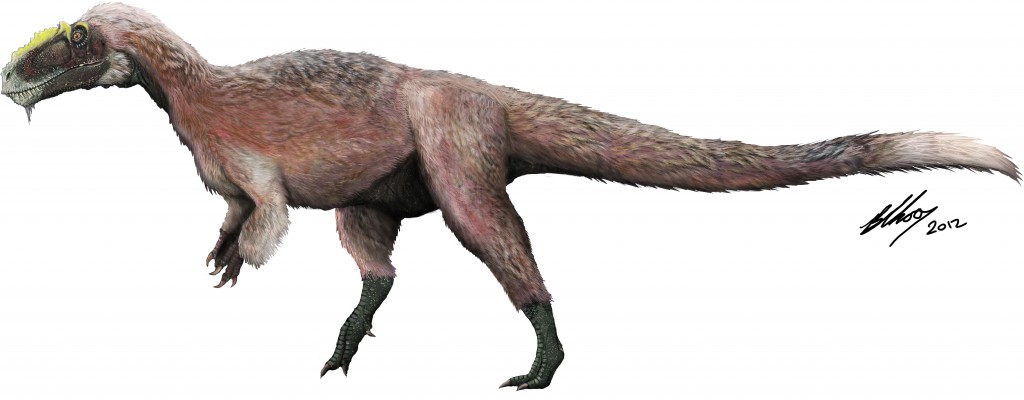Largest feathered dinosaur yet discovered in China
Posted on behalf of Leila Haghighat.
Palaeontologists have found evidence of the largest feathered dinosaur so far. The new species, Yutyrannus huali, is a member of the tyrannosaur family and may provide clues to the evolution of feathers.
In a paper published today in Nature, Xing Xu of the Institute of Vertebrate Paleontology and Paleoanthropology in Beijing and his colleagues describe finding the fossils of three Yutyrannus in the Yixian Formation of northeast China. The largest specimen is an adult dinosaur that lived 125 million years ago.
At an estimated 9 metres in length and 1,400 kilograms in weight, it is substantially larger than any feathered-dinosaur species documented since the mid-1990s.
Yutyrannus has long and bristly feathers, which the researchers suspect were used for insulation.
Large dinosaurs wouldn’t usually need feathers: their large volume relative to their surface area makes keeping warm no problem, and their weight means that flying is not an option. Even in small carnivorous dinosaurs that have feathers for insulation, the feathers’ texture is like the fuzzy down of a baby chick, according to Xu, who discussed the findings on this week’s Nature podcast.
Climate might explain why Yutyrannus needed extra insulation, says Xu’s colleague Corwin Sullivan. Geochemical data show that the first half of the Cretaceous period, when Yutyrannus lived, was at least 10 degrees Celsius cooler than the rest of the period.
The discovery of Yutyrannus also adds to the understanding of how feathers have changed over time. “As you go from the most primitive dinosaurs closer to the origin of birds, feathers become more plume-like,” Sullivan explains. Such feathers are better suited to flight than the downy variety.
Xu named the species Yutyrannus huali using a combination of Latin and Mandarin. Roughly translated, it means ‘beautiful feathered tyrant’. His team is currently working on using fossil evidence to identify the colour of the dinosaur’s feathers.
Palaeontologists have found evidence of the largest feathered dinosaur so far. The new species, Yutyrannus huali, is a member of the tyrannosaur family and may provide clues to the evolution of feathers.
In a paper published today in Nature, Xing Xu of the Institute of Vertebrate Paleontology and Paleoanthropology in Beijing and his colleagues describe finding the fossils of three Yutyrannus in the Yixian Formation of northeast China. The largest specimen is an adult dinosaur that lived 125 million years ago.
At an estimated 9 metres in length and 1,400 kilograms in weight, it is substantially larger than any feathered-dinosaur species documented since the mid-1990s.
Yutyrannus has long and bristly feathers, which the researchers suspect were used for insulation.
Large dinosaurs wouldn’t usually need feathers: their large volume relative to their surface area makes keeping warm no problem, and their weight means that flying is not an option. Even in small carnivorous dinosaurs that have feathers for insulation, the feathers’ texture is like the fuzzy down of a baby chick, according to Xu, who discussed the findings on this week’s Nature podcast.
Climate might explain why Yutyrannus needed extra insulation, says Xu’s colleague Corwin Sullivan. Geochemical data show that the first half of the Cretaceous period, when Yutyrannus lived, was at least 10 degrees Celsius cooler than the rest of the period.
The discovery of Yutyrannus also adds to the understanding of how feathers have changed over time. “As you go from the most primitive dinosaurs closer to the origin of birds, feathers become more plume-like,” Sullivan explains. Such feathers are better suited to flight than the downy variety.
Xu named the species Yutyrannus huali using a combination of Latin and Mandarin. Roughly translated, it means ‘beautiful feathered tyrant’. His team is currently working on using fossil evidence to identify the colour of the dinosaur’s feathers.

No hay comentarios:
Publicar un comentario